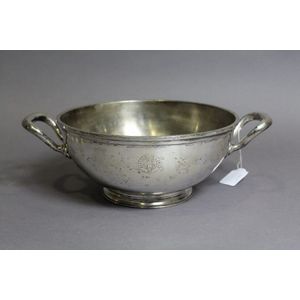Edwardian Sterling Silver Trophy with Twin Handles
You must be a subscriber, and be logged in to view price and dealer details.
Subscribe Now to view actual auction price for this item
When you subscribe, you have the option of setting the currency in which to display prices to $Au, $US, $NZ or Stg.
- Sterling Silver - Sterling silver is a mixture of 92.5% pure silver and 7.5% of another metal, usually copper. Fine silver is 99.9% pure silver, and is relatively soft and the addition of the very small amount of copper gives the metal enough strength and hardness to be worked into jewellery, decorative and household objects.
- Edwardian - The Edwardian period of English furniture and decorative arts design is named for Edward VII (1841 ? 1910) who was King of the United Kingdom and the British Dominions and Emperor of India for the brief period from 1901 until his death in 1910. It follows the Victorian period, in turn was followed by the Art Nouveau and Art Deco styles. In Australia, designs of this period are also known as being in the Federation style.
- Hallmarks - A mark stamped on articles of precious metals in Britain, since the 14th century, certifying their purity. It derives its name from the Guild Hall of the Goldsmiths' Company, who recieved its Charter in 1327 giving it the power to assay (test the purity) and mark articles of gold and silver.
The hallmark will consist of several marks, including the:
- silver standard mark, indicating the purity of the metal. Sterling silver is .925 pure silver.
- the city mark indicating the city in which it was assayed eg London, Birmingham, York etc.
- the date mark, usually a letter of the alphabet in a particular font and case,
- a duty mark, indicating whether duty had been paid to the crown, and only in use from 1784 to 1890
The piece may include an additional mark, the maker's mark, although not forming part of the hallmark, will be located in the vicinity of the hallmarks.
Sometimes silver plated items will bear faux hallmarks, often confusing those not familiar with silver markings.
This item has been included into following indexes:
Visually similar items

Christofle twin handle bowl, in silver plate marked Christofle, 62, 2942164 Approx 24 cm diameter

A fine Australian sterling silver loving cup, early 20th century, with maker's marks for Stokes & Son, with square form curved bracket handles to a simple plain bowl with monogram and raised upon a spreading foot, lightly gilt washed to the interior; hallm

A small 19th century French silver bon bon dish with two serpent handles and circular base gadrooned edging. Standard mark c.1880. Base bent. Width 14.5 cm

An Australian sterling silver cup, 20th century, with maker's mark for Proud and mark of fineness, the bowl shaped cup with a rolled rim and a small tapering foot rim, with looped handle and a flat thumbpiece. Silver weight 92gr. Height 5.5 cm
